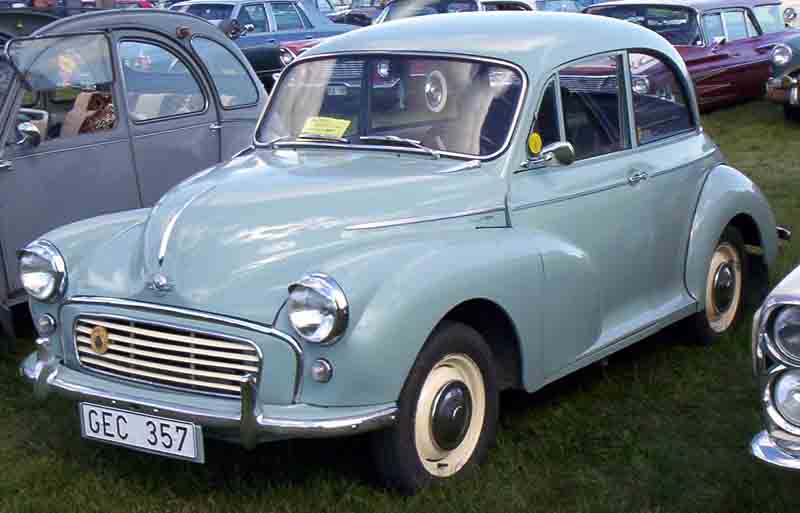
Filed Under: News
www.minormania.com
The 1000 marked the ‘coming of age’ for the Minor. Introduced in 1956, this was the last major upgrade that Britain’s then most popular car would receive. The ‘1000’ would also see the production of the one millionth Minor, the greatest number ever produced in Britain of a single model car. The ‘Morrie Thou’ would also see BMC begin to concentrate on their other models, the Mini and the 1100 in particular getting most of the development work. The ‘1000’ was beginning to fade into the background as BMC left the Minor to rest on its (unexpected) laurels. But that’s still a few years away yet, let’s go back to 1956 and see how the Minor came of age.

 A number of changes were made for the 1956 model that differentiate the ‘1000’ from the venerable Series II. Most obvious was the fitment of a single curved windscreen in place of the two piece split-screen and also a larger rear window. This provided much improved visibility and cleaner, smoother lines to the already curvy body style, although the ‘clap hands’ window wipers, a necessity due to the previous split-screen, remained unchanged for another 6 years. Another visual change was the introduction of the 5-bar grill, replacing the ‘cheese-grater’ grill of the Series II.
A number of changes were made for the 1956 model that differentiate the ‘1000’ from the venerable Series II. Most obvious was the fitment of a single curved windscreen in place of the two piece split-screen and also a larger rear window. This provided much improved visibility and cleaner, smoother lines to the already curvy body style, although the ‘clap hands’ window wipers, a necessity due to the previous split-screen, remained unchanged for another 6 years. Another visual change was the introduction of the 5-bar grill, replacing the ‘cheese-grater’ grill of the Series II.
 But the changes went far deeper than just the windows. The most important improvement over the Series II was the replacement of the increasingly inadequate 803cc engine with the larger and sweeter 948cc unit, hence the tag ‘1000’. With a higher compression ratio of 8.3:1 the power of the 948cc engine was a very creditable 37BHP, making it more than a match for its 1950’s rivals. The gearbox still had no syncromesh on first gear, but the ratios were improved and changing the gears was much smoother. Coupled with the extra power available, driving a 948cc Minor was like a breath of fresh air compared to the wheezy Series II. At last the Minor could reach the dizzying speed of 70MPH on a flat road – no need for long downhill runs anymore.
But the changes went far deeper than just the windows. The most important improvement over the Series II was the replacement of the increasingly inadequate 803cc engine with the larger and sweeter 948cc unit, hence the tag ‘1000’. With a higher compression ratio of 8.3:1 the power of the 948cc engine was a very creditable 37BHP, making it more than a match for its 1950’s rivals. The gearbox still had no syncromesh on first gear, but the ratios were improved and changing the gears was much smoother. Coupled with the extra power available, driving a 948cc Minor was like a breath of fresh air compared to the wheezy Series II. At last the Minor could reach the dizzying speed of 70MPH on a flat road – no need for long downhill runs anymore.
The available colour schemes became marginally more daring, with the introduction of such exciting colours as Old English White, Chartreuse Yellow and later with the Lilac Millions. The ‘1000’ was offered in no less than 33 different colours! The upholstery also got the treatment with two-tone schemes making an appearance.
1962 saw the introduction of the 1098cc engine, basically a long-stroke version of the 948. This gave the car a little more power and would have improved the top-end cruising speed were it not for the fact that a lower ratio diff was fitted at the same time, reducing the top speed of the 1098 to only 4 miles per hour more than the 948. The benefit was therefore only seen in the torque or pulling power of the engine. Hills that once required the driver to change down to third gear became easy fourth gear climbs. Although it provided more power than the 948 and allowed slightly higher cruising speed, the 1098cc engine was never as smooth or refined-sounding as its little brother, although the stronger gearbox was a welcome change.
 The 1098 Minor also received a few subtle changes over the 948 including the introduction of ‘normal’ synchronised wipers instead of the ‘clap-hands’ units. The front indicator/park lights were enlarged and changed to include a separate amber indicator. The taillights were also redesigned resulting in a larger unit and again incorporating a separate amber indicator.
The 1098 Minor also received a few subtle changes over the 948 including the introduction of ‘normal’ synchronised wipers instead of the ‘clap-hands’ units. The front indicator/park lights were enlarged and changed to include a separate amber indicator. The taillights were also redesigned resulting in a larger unit and again incorporating a separate amber indicator.